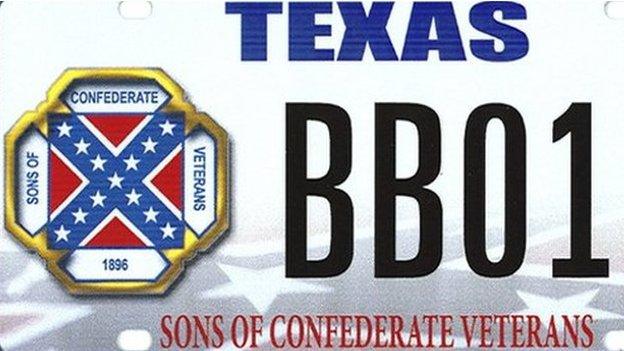The man with 7,000 licence plates
- Published
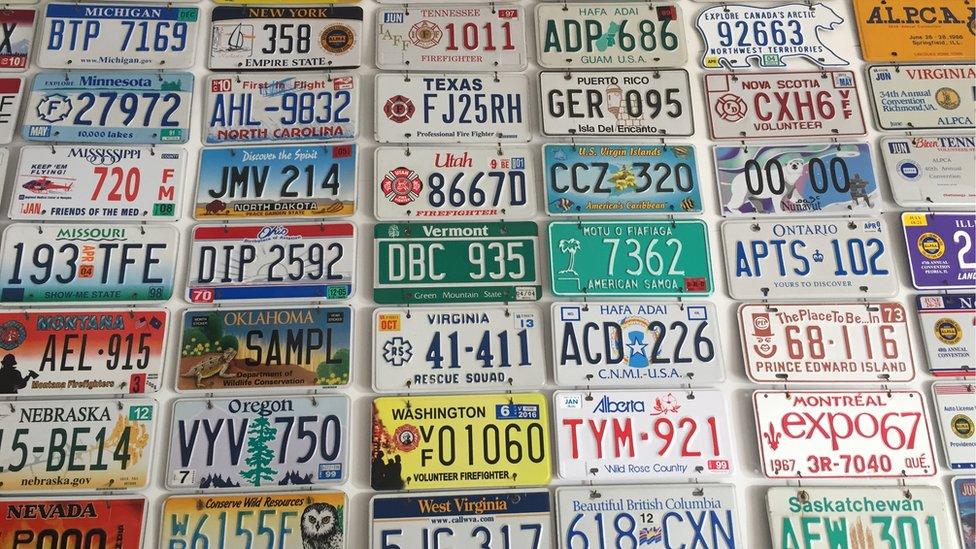
Part of Andrew Pang's display
American car registration plates have become aluminium works of art and collecting them has never been more popular.
On a quiet street in Arlington, Virginia, one man has squeezed the whole world into his garage.
On one wall, all 50 states of America. Next to it, all 13 of Canada's provinces and territories.
Most of Mexico is above the garage door, while another wall zips from continent to continent: Montenegro one minute, Micronesia the next.
Andrew Pang has spent 40 years collecting plates, and every sheet of metal tells a story.
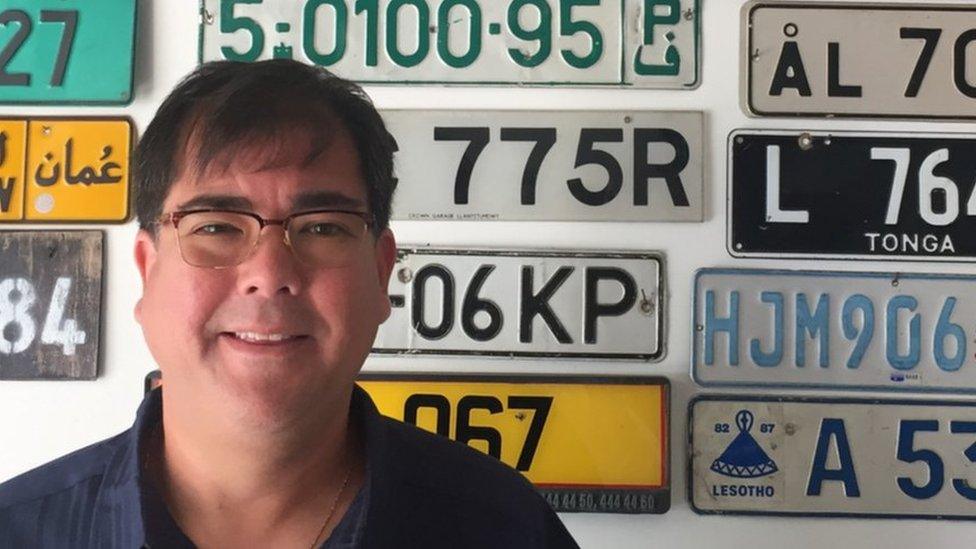
Andrew has "between 7,000 and 8,000 plates". He received his first aged seven while growing up in Virginia.
"My friend and neighbour across the street was from Louisiana, and he would go back every summer," says Andrew.
"One summer I said 'bring me something back from Louisiana'. He chose to bring me a licence plate from his grandfather's car dealership."
Andrew had "dabbled" in stamp collecting and "had developed an interest in other countries, geography, maps".
When Louisiana landed in his lap, he decided to start collecting. "I thought 'everyone collects stamps'," he says. "This was a little different."

In the US, licence plates are issued by states / territories
When plates expire, they can be bought and sold by collectors
Some states issue hundreds of types of plates, usually to raise money or awareness for good causes

By the time Andrew was 12, he had a plate from all 50 states. His next challenge was collecting a Virginia plate from every year they were issued.
Virginia has issued plates since 1906.
"It took me 25 years to complete," says Andrew.
He found the missing piece of the jigsaw when a woman in Fredericksburg, Virginia, sold her deceased husband's collection. He bought a dozen plates - including the 1906 - for "around $4,000".
After completing the Virginia set - or "run", to use the terminology - Andrew looked for new worlds to conquer. Or new states, at least.
He spent four years in Texas, and completed its run. He now wants the set from all 50 states, plus the District of Columbia, but admits it will take time.
"I'm very close on DC, Maryland, North Dakota," he says. "But I particularly focus on quality (the plate's condition). I could have finished many (runs) if I took anything."
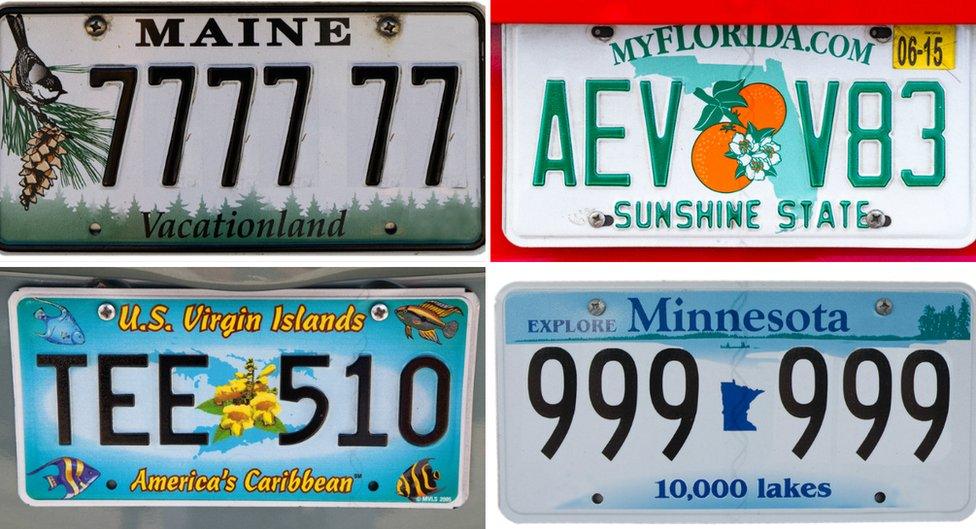
Many states and territories use their plates to advertise their attractions
When Andrew started collecting plates, the hobby was an "oddity", he says. But two things have changed that: the internet, and the trend for colourful, well-designed plates.
"Many of the plates in the old days were very, very boring," he says. "At the time their only reason was for identification: two colours, no pictures, no designs.
"With a few notable exceptions, the first real foray into more interesting graphics was 1976 for the US bicentennial (the 200th anniversary of the Declaration of Independence).
"At that time, quite a few states offered very specific bicentennial plates to everyone."
The next marker, says Andrew, was in 1986. After the Challenger space shuttle disaster, Florida issued a plate with a rocket design to raise funds for the Astronauts Memorial Foundation.
States began to realise the potential of plates, and the era of brighter, distinctive designs began. Oregon's plates have a fir tree, for example. North Dakota's have a bison. Florida's have two oranges.
The effect, when driving on American roads, is twofold. On one hand, the country seems vast: it's not uncommon in DC to see plates from California, 3,000 miles away, for example.
On the other, it makes the country seem smaller, more interesting, and more united: oh look, there goes someone from Maine, or Michigan, or Montana. We're all Americans here.
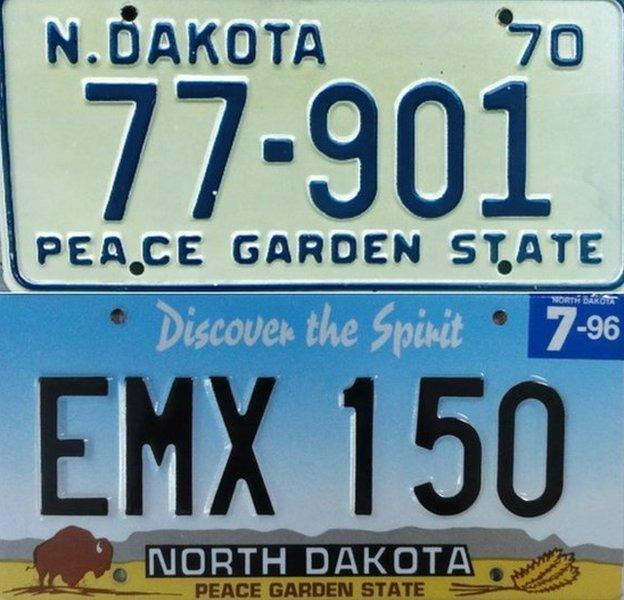
Plates design began to change in the 1970s - as seen in these examples from 1970 and 1996
There is, of course, another reason for the rise in well-designed plates.
"The American population is very mobile," says Andrew, a 47-year-old accountant. "This summer we drove 6,000 miles across the country, and that's not unusual.
"The states realised, 'here's my person from Virginia, people are going to see his licence plate, let's do something'.
"If you're in Florida, you're nowhere near a mountain, but you see a car from Colorado and they have the snow-covered peaks on the plate.
"South Carolina, Pennsylvania, and many others put their tourism website on their licence plate. In many ways they have replaced the bumper sticker. It's free advertising."

Massachusetts issued the first licence plate in the US in 1903
American plates have been made from materials including porcelain, copper, and fibreboard
Among the rarest plates are 1913 Mississippi and 1921 Alaska. "When they change hands, it's in the low five figures," says Andrew

The Automobile License Plate Collectors Association began in 1954. It has almost 3,000 members from all 50 states and 19 countries.
Around 500 people attend its annual conventions, and there are smaller, regional meetings too. Jeff Minard became a member in the 1960s, aged 15.
"Your member number is related to when you joined," says Jeff. "My number is 495. There are very few three-digit members alive."
Jeff says licence plate collecting has become "enormous", although he distinguishes between "serious" collectors, such as the association's members, and those who may have a dozen or so in their garage.
"I'm not dismissing them at all (the less serious collectors)," he says. "But we're a little more academic, if I can put it like that."
One collector in Florida has 50,000 license plates. "Unbelievable," says Jeff.
Jeff himself has 500, after downsizing his collection from 5,000. "I sold a lot," he says. "I'm finding homes for them. I don't want someone (else) to have to do that.
"We just hope they don't get recycled for aluminium."

Part of Andrew's international collection - including the Monaco plate (0000)
Back in Arlington, Andrew Pang looks at the international plates on his garage wall. In between Albania and the Bahamas is a 1998 plate from Monaco, still in a plastic wrapper.
"I wrote to the prince, asking for a plate," he says. "I didn't expect anything to happen, but it arrived in the post a few weeks later."
Most of Andrew's plates, however, are bought online, rather than from royalty.
He has plates from former countries, such as East Germany, disputed territories, such as South Ossetia in eastern Europe, and moments in history, such as when Iraq occupied Kuwait.
He even has a plate from the pacific island of Vanuatu. It is made from wood.
Andrew is missing plates from around 40 countries and territories. The Pitcairn Islands - a tiny British territory in the south Pacific - are proving tricky, while the Vatican City is "tightly controlled".
Could you buy one, if money wasn't an issue?
"Probably, but you're talking high hundreds (of dollars), maybe low thousands," he says.
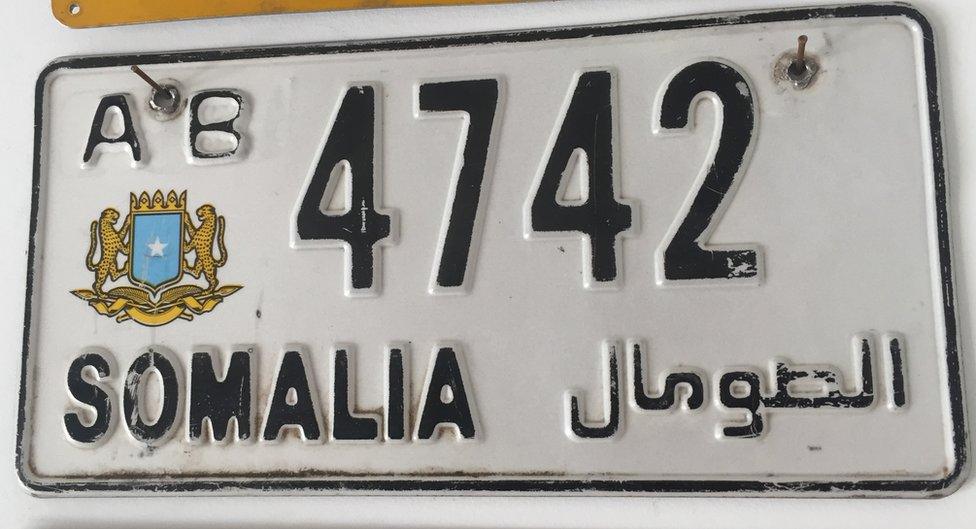
Andrew has plates from most countries
Despite having walls covered in plates, does Andrew still glance at every back bumper he passes?
"I am afflicted with that," he admits.
"Just yesterday I saw a vehicle in a parking lot from Puerto Rico, and that's quite unusual. In this area [near DC] I look for diplomatic plates.
"What really excites me is if I see a US diplomat that's coming back from another country, but they're back such a short period of time, the plates from the other country are still on the vehicle."
And what does his wife make of it all?
"My wife is less of a hobbyist than I am," says Andrew, smiling.
"While she has grown to understand it and live with it... she doesn't necessarily embrace it."
- Published10 September 2015
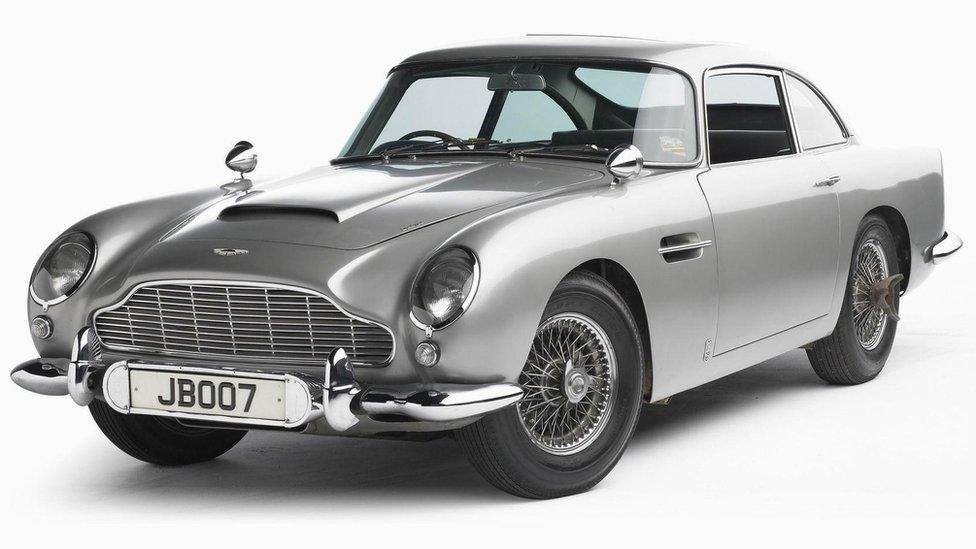
- Published24 March 2015
